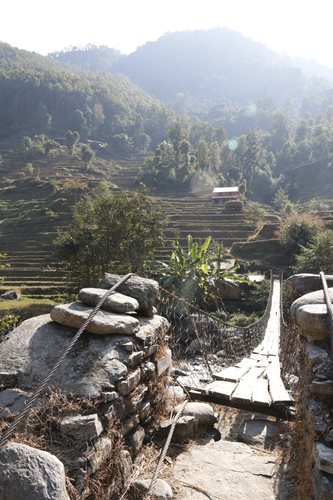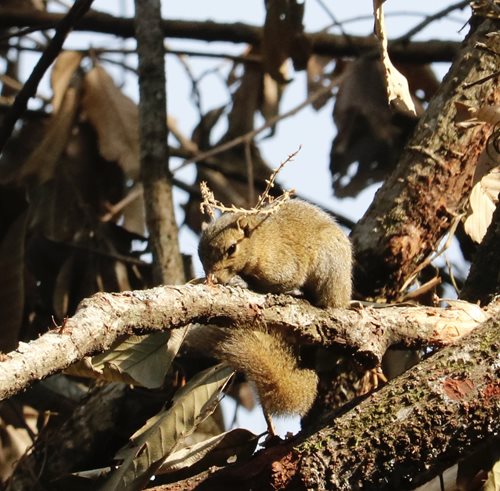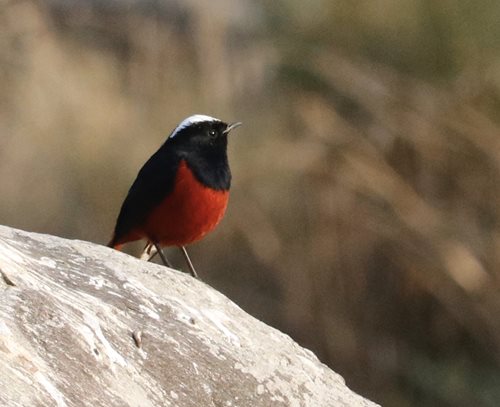I awake to one of those cold misty mornings where the world is rendered mysterious. The river sounds close but I can’t see it. I can see the silhouette of a man squatting as he works at the top of the house he’s rebuilding. There’s a skeletal tree where two motionless crows are perched looking too black to be anything natural. Sounds are muted and the air smells different. The people of Nuwakot are wrapped against the penetrating cold in shawls and woolly hats; some have scarves tidied under their chins as if they have toothache. Some huddle warming their hands on burning piles of rubbish. Those lucky few who can afford them wear down jackets.
It will be hours before the sun punches through the miasma and brings warmth.
Yesterday was a better. I tagged along with S and two Nepali colleagues on a field trip which included attending a gaonpalika meeting. Recent elections aim to decentralise government and the gaoonpalika is a new administrative unit – there are 10 to 12 in each of Nepal’s 75 districts – and they now have a budget and some power. Some of S’s work on rebuilding after the earthquakes will be with them.
The meeting – in Shivapuri gaonpalika – was one of three aiming to give everyone their chance to speak so it was long and at times passionate. I didn’t need to attend and left the men in their chilly meeting room (women were notable by their absence – except for the deputy mayor and three others who put out the chairs). I wandered off with my camera.
The gaonpalika office was at abut 700m above sea level overlooking the upper reaches of the Likhu river on the edge of the Shivapuri National Park. To the north and south the steep valley-sides rose to 1600 – 2000m. A little downstream from the office was a footbridge made in the usual way with four steel cables stretched across the river between two concrete and boulder abutments. The lower two cables support the footway and the upper should act as handrails although in this bridge the upper two were below waist height; someone had shoved rocks under the cables in an attempt to raise the level. Many of the boards on which I stepped were broken or looked about to break so the structure hardly inspired confidence. I felt I was being whimpy until a granddad, two grandchildren and three goats came across and the two little girls looked distinctly nervous at the mid-point where the boards were worst.
We all crossed safely though, and I sauntered up through a network of paths giving access to terraces, some fallow, some brimming with winter wheat of the richest of greens. I discovered later that I had entered a conservation zone and the steepest gullies, being uncultivatable, were left to the forest. Even so, trees are a valuable resource for the villagers – for fodder, fuel and timber. They also aid water conservation.
Tree-pies, striking birds with ridiculously long tails played hand-and-seek with me but odd movements in the leaves drew my attention to a scamper of small russet squirrels. I settled down to wait for one to venture out to a branch end so I could take a photograph when I heard, ‘Hello madam!’ above me. Three young men were – I assume – working in a terrace on the other side of the forested gully, and were lined up along my horizon waving. Fortunately the squirrels weren’t spooked by noisy humans and a little later I snapped one cute little lass who had found a horizontal branch in the sun and had started to doze off. She looked like she’d eaten well that morning.
At this time of the year (early Jan) it is uncomfortably cool in the shade of the forest so I repaired to the river and found a comfortable boulder to sit on and waited to see who would appear. Perky plumbious redstarts were the commonest – these are small but pretty deep blue birds with bright red tails that they flick to draw attention to themselves. They take up positions on mid-river boulders that give the best prospects for hunting, so sometimes there were tussles for key positions. Then a larger, more striking bird swept in to establish its dominance.
A shadow fell across me and I turned to see that the watcher was being watched – by a wrinkled woman carrying a huge quantity of fodder suspended from a headband. She didn’t ask what I was doing but did ask ‘Where are you from? Are you alone? What’s in your bag?’ I responded with ‘Where is your house?’ and seemingly satisfied she wandered off to feed her cows.
As I turned back to the river I caught a flash of almost luminous blue. A tiny explosion of colour swept in, hovered and plunged into the river. As the kingfisher surfaced with a small silvery morsel I was treated to a good view of his sun-orange breast and gorgeous blue feathers.
This had certainly been a more enjoyable way to pass the afternoon than my husband and his colleagues had, who were emerging from the office looking very very cold.
 |
| Bridge across the river Likhu that is in need of repair |
 |
| A tiny hoary-bellied squirrel dozing off on a sunny branch |
 |
| White-capped water-redstart |
 |
| Whitebait was this chap's prize for braving the icy river Likhu |
There are more Nepal photos on instagram @wilson.howarth